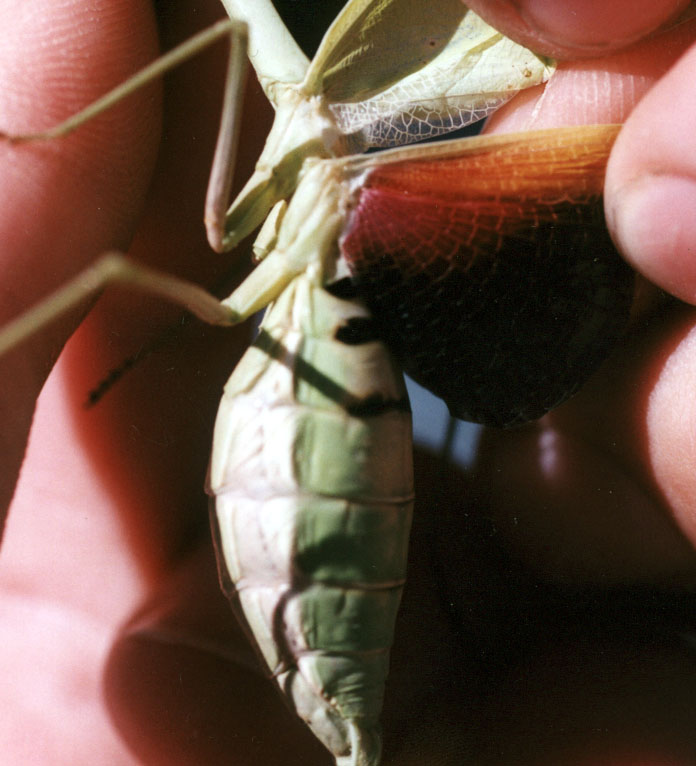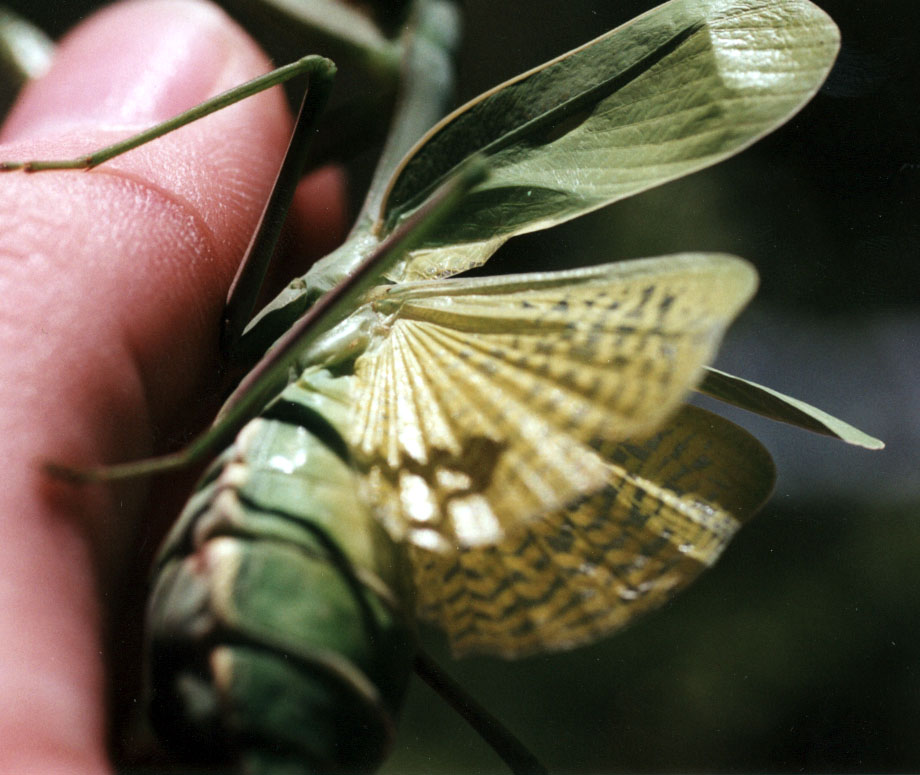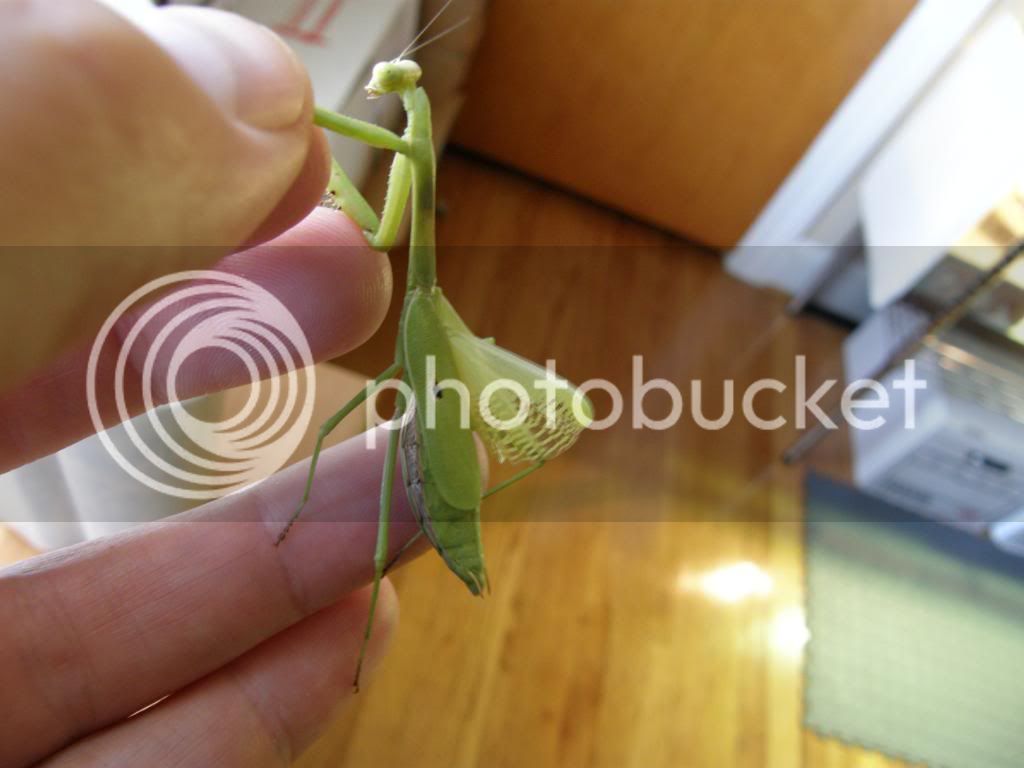Ya know what Doug I never noticed the wings. You are right on that. They are longer than they should be. That along with the black marks on the front legs really have me wondering!none of my limbata females had wings that long, they all ended about half way, the male looks just like my last S limbata, the female(if i had to guess) is no limbata just because her wings are extremely long.
You are using an out of date browser. It may not display this or other websites correctly.
You should upgrade or use an alternative browser.
You should upgrade or use an alternative browser.
All of a sudden..
- Thread starter keolablue
- Start date

Help Support Mantidforum:
This site may earn a commission from merchant affiliate
links, including eBay, Amazon, and others.
d17oug18
Well-known member
maybe its a chamo chinese? my bro has one that looks similar to that one and i just told him it was a chinese female lol
MantidLord
Well-known member
I agree with rick that its a stagmomantis sp. I've seen those markings on limbata nymphs but never on a female, and the wings are a little long. Definitely not M. religiosa nor I. oratoria. Good luck.
Ntsees
Well-known member
In my opinion, both of them are Stagmomantis limbata. I say both are the same species because (in addition they look like and males and females of Stagmomantis limbata) the male was able to connect with the female. In my limited experience, mantids of different species are not able to make the connection (I want do know those that can if it's even possible). It's like how the wrong key won't be able to open the door. The female looks like her wings are long only because she hasn't had anything to eat. Feed her a lot and I'm certain that her abdomen will stretch (as well as fatten) so that she'll look more like the typical short-winged females for that species. Keep us all updated.
Last edited by a moderator:
d17oug18
Well-known member
naw man, there are A LOT of species that can connect, my male S. Limbata connected to a S. carolina, and ive heard of other species that have connected, it is possible and it CAN happen. Ive had limbatas and there wings are never that long, and if she is that small, wouldnt let a male mate (easily) that early.(meaning she just shed)
kamakiri
Well-known member
Yes.Is it possible for mating to occur more than once if the female already had contact and may already be fertilized?Are there clear ways to tell if she is fertilized afterward?
No. But after several hours of mating and the male leaving on his own...She is most likely fertilized.
And those two are pretty clearly S. limbata everybody. I don't see what all the confusion is!
Feed the girl well! She doesn't look like she's had much to eat.
No confusion here. I have maintained that is what they are however the female does have long wings and marks on the front legs. I do get tired of people swearing it is something it obviously isn't.Yes.No. But after several hours of mating and the male leaving on his own...She is most likely fertilized.
And those two are pretty clearly S. limbata everybody. I don't see what all the confusion is!
Feed the girl well! She doesn't look like she's had much to eat.
ABbuggin
Well-known member
I think I know what it is.  I have been doing some internet browsing trying to figure it out and I believe that it is a Stagmomantis, californica.
I have been doing some internet browsing trying to figure it out and I believe that it is a Stagmomantis, californica.
Check this link out (3 pics), I know the wings are shorter, but look at the coloration of the wings, the coloration of the arms etc. We know that wing size can vary amongst mantids (my Creobroter, nebulosa males' wings varied a lot) so that may not be a vital identification mark. Let me know what you guys think, but it is the closest thing I've found.
http://bugguide.net/node/view/84658
Edit: Found another pic (still has short wings, but the coloration is the same)
http://images.google.com/imgres?imgurl=htt...t%3D18%26um%3D1
Check this link out (3 pics), I know the wings are shorter, but look at the coloration of the wings, the coloration of the arms etc. We know that wing size can vary amongst mantids (my Creobroter, nebulosa males' wings varied a lot) so that may not be a vital identification mark. Let me know what you guys think, but it is the closest thing I've found.
http://bugguide.net/node/view/84658
Edit: Found another pic (still has short wings, but the coloration is the same)
http://images.google.com/imgres?imgurl=htt...t%3D18%26um%3D1
Last edited by a moderator:
Ntsees
Well-known member
Nice. Thanks! I had no idea only because I'm so limited to the species within my area. So it is possible, interesting!naw man, there are A LOT of species that can connect, my male S. Limbata connected to a S. carolina, and ive heard of other species that have connected, it is possible and it CAN happen. Ive had limbatas and there wings are never that long, and if she is that small, wouldnt let a male mate (easily) that early.(meaning she just shed)
Ntsees
Well-known member
I don't know. There haven't been enough info/pictures about Stagmomantis californica for me to say that the mantid could be it.I think I know what it is.I have been doing some internet browsing trying to figure it out and I believe that it is a Stagmomantis, californica. Check this link out (3 pics), I know the wings are shorter, but look at the coloration of the wings, the coloration of the arms etc. We know that wing size can vary amongst mantids (my Creobroter, nebulosa males' wings varied a lot) so that may not be a vital identification mark. Let me know what you guys think, but it is the closest thing I've found.
http://bugguide.net/node/view/84658
Last edited by a moderator:
ABbuggin
Well-known member
That's exactly what I ran into, only like 3 or 4 pages on google. <_< I did search the other Stagmomantis species, and these pics match the "mystery" the best.I don't know. There haven't been enough info/pictures about Stagmomantis californica for me to say that the mantid could be it.
Keolablue..... Could you feed the female until she is fat? I would think her wings would be shorter than her abdomen when she is full.
Last edited by a moderator:
cloud jaguar
Well-known member
My vote goes to S. Limbata based on the coloration of both and the shape of their prothorax - I have a nearly identical colored female.
However, as Doug and Rick have discussed, the wings do seem somewhat long for an S. Limbata female which is weird Usually the wings rest on the saddle only a bit past 1/2 way down the back!
Usually the wings rest on the saddle only a bit past 1/2 way down the back!
However, as Doug and Rick have discussed, the wings do seem somewhat long for an S. Limbata female which is weird
Last edited by a moderator:
kamakiri
Well-known member
Agree here. While I *thought* I had a good indicator of S. limbata vs. S. californica with the female yellow vs. dark hind wings...I'm not so sure now.I don't know. There haven't been enough info/pictures about Stagmomantis californica for me to say that the mantid could be it.
Perhaps it is that these two are:
A.) genetically the same, but have two names.
B.) closely related enough to cross-breed with no ill-effect.
C.) mis-identified due to presence of limbata in California.
The gray female that I recently caught has dark/clear hindwings...While outwardly she looks like limbata to me with the arm patterns and all...She might simply be californica...
EDIT: B ) without the space is B) !
EDIT 2: The gray female does not have dark speckled wings as I thought I saw from under the forewings. They are yellowish/clear speckled. Pretty sure that makes her limbata too.
Last edited by a moderator:
kamakiri
Well-known member
Okay here we go:
From this page
both images below copyright Michael R. Maxwell.
S. californica:
Solid red to black hind wing and black marking on first few tergites:

S. limbata:
While this is a yellow sample, the speckling/patterning is the differentiator:
I'll put up the speckling from my gray limbata tonight.

From this page
both images below copyright Michael R. Maxwell.
S. californica:
Solid red to black hind wing and black marking on first few tergites:

S. limbata:
While this is a yellow sample, the speckling/patterning is the differentiator:
I'll put up the speckling from my gray limbata tonight.

Last edited by a moderator:
Ntsees
Well-known member
Nice find Kamakiri! Those wing pictures do show the difference between a californica and a limbata. Now, one more step: can someone who currently has the carolina species look to see if the carolina lack/has the dark horizontal bands on the abdominal tergites as well as wing coloration? Thanks.
Also, I think I found an error to one of the pictures. The last picture (1st column third picture down) is in no way a Carolina mantid. It looks more like an Iris oratoria to me.
Also, I think I found an error to one of the pictures. The last picture (1st column third picture down) is in no way a Carolina mantid. It looks more like an Iris oratoria to me.
Last edited by a moderator:
kamakiri
Well-known member
Agreed on that I. oratoria picture/error. This is when I hate the internet...misinformation.Nice find Kamakiri! Those wing pictures do show the difference between a californica and a limbata. Now, one more step: can someone who currently has the carolina species look to see if the carolina lack/has the dark horizontal bands on the abdominal tergites as well as wing coloration? Thanks.Also, I think I found an error to one of the pictures. The last picture (1st column third picture down) is in no way a Carolina mantid. It looks more like an Iris oratoria to me.
Here is a pic of a green s. carolina. It looks basically the same as the limbata. Those two are so close that I can't really know the difference.Agreed on that I. oratoria picture/error. This is when I hate the internet...misinformation.

Last edited by a moderator:
Ntsees
Well-known member
Yes! Thanks Rick. I think you mentioned in another post that the carolina has the black speck on the forewing whereas the limbata doesn't (whatever the color of the mantid may be, the "speck" won't be black). Until proven wrong (if I'm wrong, tell me because the most important thing for me is the TRUTH), I'm going to use that physical description (the black speck) as the key to distinguishing carolina from limbata (along with the fact the the abdomen of the limbata appears more circular when viewed from top/bottom). From many past searches, all three have the banded tibia and so that cannot be used to differentiate between them.
This is enough evidence for me. Stagmomantis californica for me now will be distinguishable with the red/purple/black underwing since the other related species (limbata and carolina) do not have it. I don't know about you guys, but this forum has just solved my most biggest and puzzling question: How to distinguish the californica from the other related species(limbata and carolina). WHOOOOHOOOOO!!!

This is enough evidence for me. Stagmomantis californica for me now will be distinguishable with the red/purple/black underwing since the other related species (limbata and carolina) do not have it. I don't know about you guys, but this forum has just solved my most biggest and puzzling question: How to distinguish the californica from the other related species(limbata and carolina). WHOOOOHOOOOO!!!
Last edited by a moderator:


